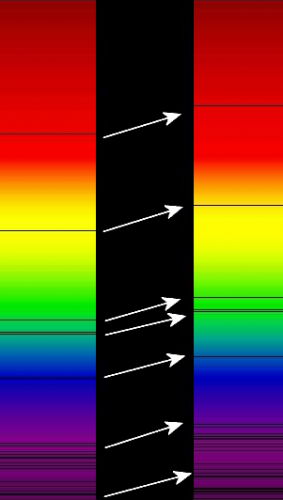But what were they? Astronomers captured their spectra and had a look. The spectra looked really odd, until they figured out that they were extremely redshifted. Redshift is a nifty astronomy tool. Here's how it works:
 |
| Original spectrum vs a redshifted spectrum |
The greater the redshift, the farther away an object is. The spectrum sampled from quasars were so redshifted it took us a while to figure out just how redshifted they were.
In other words, these really bright radio sources were really, really far away. That was doubly-amazing because of the Inverse Square Law--intensity reduces with distance.
"Dude!" we cried. What could possibly create so much energy to be so bright from so far away?
Eventually, we figured out quasars were really, really active distant galaxies and that the extreme energy output came from the accretion disks of the supermassive black holes in the middle of those galaxies. Those suckers can really put on a shine when actively consuming some poor star.
(Is our own Milky Way a quasar? Currently no, as our Sagittarius A* is a rather quiet supermassive black hole at the moment.) Quasars are believed to be an early universe phenomenon because we observe them as coming from waaay back in time. But that doesn't mean that Sgr A* couldn't become a quasar in the future, given enough to eat.
So we figured out that quasars are:
- really old
- really distant
- really bright
Want to know more about quasars?
- Easy tricycle level (with training wheels)
- Mountain bike level (for the average science-curious layman)
- Hardcore Harley Davidson level:
__________________________________
Her Grace prefers to study objects that are a little bit closer than z=7.085.

6 comments:
I like your designation of the levels of papers on quasars :) I've been reading science stuff (for lay people) for the last 20+ years, but this stuff still bends my brain. I'll take the training wheels.
The Ninja Librarian’s Favorite Characters
A very succinct explanation. Great info.
Dropping by from the A to Z Challenge
----------
Sandra, Aspiring family historian, fellow participant in the #AtoZchallenge
Sandra's Ancestral Research Journal
I'm loving the science - I know some science, but I had no idea what Quasars were - thanks for the info.
Phillip | Q is for Quidditch
“Quasi-stellar Objects” just sounds cool, but that aside your post is really fascinating. Thanks for sharing.
Thanks for visiting my post: Q for Quiet.
Shari
Fascinating. I was recently wondering about quasars, so I'm glad to have read this. :)
A to Z 2017: Magical and Medicinal Herbs
I could have written about quasars, but instead added "Queen" to Cassiopeia (there were just to many C constellations to write about, so I had to share the wealth with other letters). Besides, you understand this a lot better than me. An interesting post.
http://sagecoveredhills.blogspot.com/2017/04/w-is-for-white-dwarf.html
Post a Comment